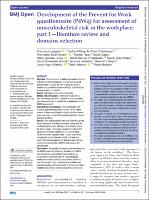Por favor, use este identificador para citar o enlazar este ítem:
https://repositorio.usj.es/handle/123456789/692
| Título : | Development of the Prevent for Work questionnaire (P4Wq) for assessment of musculoskeletal risk in the workplace: part 1-literature review and domains selection |
| Autor: | Langella, Francesco



Christensen, Steffan Wittrup Mc Phee 

Palsson, Thorvaldur S. 


Høgh, Morten 
Gagni, Nicolo Bellosta-López, Pablo 

Christiansen, David Høyrup 

Delle Chiaie, Mauro 
Doménech-García, Víctor 

Johnston, Venerina 

Szeto, Grace 

Villafañe, Jorge Hugo 


Herrero Gállego, Pablo 


Berjano, Pedro L. 


|
| Fecha de publicación: | 2021 |
| Editorial : | BMJ Journals |
| Citación : | Langella F, Christensen SWMcP, Palsson TS, et al. Development of the Prevent for Work questionnaire (P4Wq) for assessment of musculoskeletal risk in the workplace: part 1—literature review and domains selection. BMJ Open 2021;11:e043800. doi:10.1136/ bmjopen-2020-043800 |
| Resumen : | Objective:This study aims to define appropriate domains and items for the development of a self-administered questionnaire to assess the risk of developing work-related musculoskeletal disorder (WMSD) and the risk of its progression to chronicity. Design: Literature review and survey study. Setting and participants: A literature review and a two-round interview with 15 experts in musculoskeletal pain were performed to identify the available domains for WMSD assessment. Interventions and outcome: To ensure quality, only validated questionnaires were included for the Delphi process. A three-round Delphi method, with three round steps, was used to select the most pertinent and relevant domains and items. Results: Nine questionnaires were identified through the expert discussion and literature review, comprising 38 candidate domains and 504 items. In the first round of the Delphi group, 17 domains reached more than 70% agreement and were selected. In the second round, 10 domains were rejected, while 11 were selected to complete the pool of domains. In the third and final round, 89 items belonging to 28 domains were defined as significant to develop a WMSDs risk assessment questionnaire. Conclusions: No specific risk assessment questionnaires for WMSDs were identified from the literature. WMSD risk of presence and chronicity can be defined by an assessment tool based on the biopsychosocial model and the fear-avoidance components of chronic pain. The present study provides the formulation and operationalisation of the constructs in domains and items needed for developing and validating the questionnaire. |
| URI : | https://repositorio.usj.es/handle/123456789/692 |
| ISSN : | 2044-6055 |
| Aparece en las colecciones: | Artículos de revistas |
Ficheros en este ítem:
| Fichero | Descripción | Tamaño | Formato | |
|---|---|---|---|---|
| Development of the Prevent for Work questionnaire (P4Wq) for assessment of musculoskeletal risk in the workplace part 1—literature review and domains selection.pdf | 564,13 kB | Adobe PDF |  Visualizar/Abrir |
Este ítem está sujeto a una licencia Creative Commons Licencia Creative Commons

